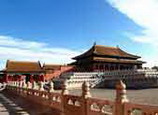
QENA, Egypt, May 29 (Xinhua) -- With fading huge blocks, cracked walls, dusty, grassy floors, leaning columns and gloomy stairs and chambers, the deserted Roman Temple of Isis, also known as Shenhur Temple, lies at a small village in Qena governorate in Egypt.
Suffering from a great deal of damage over centuries due to stone robbing, lime burning and groundwater, Shenhur Temple, around 450 km south of Cairo and 20 km north of the country's ancient capital Luxor, is not open for tourists.
"Groundwater greatly damages the walls of the temple and its ancient Roman engravings," said Hussein Ahmed Hussein, an archeological expert at Luxor governorate.
Hussein told Xinhua that the Roman temple had great historic significance and that "Pharaonic King Ramses II, who ruled Egypt from 1304 to 1237 B.C., once camped with 200 of his soldiers at Shenhur Temple."
The expert said the governments of ex-president Hosni Mubarak, who ruled Egypt for about three decades, were to blame for the deteriorating conditions of such a legacy, noting that the current culture minister, who assumed office in a cabinet reshuffle only a few weeks ago, should pay attention to the temple.
"The culture ministry closed the temple due to its inconvenience at the current stage, but the temple must be restored and included in Egypt's tourist attractions map," Hussein recommended, adding that the engineering college of Cairo University started a project before the 2011 upheaval to protect the temple from groundwater but it stopped after the unrest.
"Belgian and French archeological teams made topographic scanning for the whole temple to rescue it from groundwater but they also had to stop after the uprising due to lack of security," Hussein told Xinhua, noting the teams discovered ancient inscriptions for some Roman emperors.
Located behind a mosque and a tomb at Shenhur site of Qus town in Qena, the temple consists of three halls and a front yard with some remaining columns. The temple is said to have two crypts leading to two other distant temples in the area.
Shenhur Temple also has two large walls and a corridor around the main sanctuary leading to several chambers aside, including a chamber dedicated to the New Year rituals. The walls show inscriptions of Roman emperors worshipping some ancient gods.
The residents of Shenhur complained that the temple had become a target for "monument mafia" due to the lack of guards and the negligence of the concerned government.
"The temple has become a garbage dump after the antiquities authority withdrew its guards," said Abdel-Hayy Ibrahim, a resident of Shenhur who is a teacher.
"The current deteriorating conditions of the temple shows it had been completely removed from the Egypt's tourist map, although it could change the village's future if restored," Ibrahim told Xinhua.
"How come the government wants to boost tourism while neglecting such a great temple and leaving it without restoration? " Obaid al-Haggan, another resident of Shenhur, wondered.
"The temple has already been subjected to robberies and illegal excavations in search for treasures," said Taha Mohamed Salama, a lawyer from the village.
His neighbor Mansour Reyad, a farmer, said that the temple was robbed many times, "the latest was several years ago when some officials were involved and the issue stirred up the public opinion then."
In March 2008, Cairo Criminal Court sentenced 16 convicts, including a former prosecutor, from three to seven years in prison over looting Shenhur Temple.
















 Modern movie dream in retro Mingguo street
Modern movie dream in retro Mingguo street


![]()
